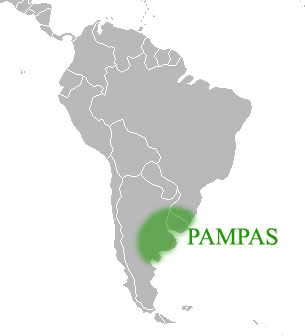pampas
THERE ARE MANY types of GRASSLANDs worldwide, especially in the continental interiors of temperate to subtropical regions. That of South America is known as the pampas, a Spanish term. The pampas occupies some 270,270 square mi (700,000 square km) in the countries of ARGENTINA, URUGUAY, and southeast BRAZIL. Here, there are extensive plains with isolated low hills in a region where the major drainage system is the River Plata. Climatically, average temperatures range from 43 to 79 degrees F (6 to 26 degrees C); only mild and short-lived frosts occur during the winter months (July and August), but summer temperatures can reach 104 degrees F (40 degrees C).
The pattern of precipitation mirrors that of other continental grasslands such as the North American prairies with an east-to-west gradient that ranges from 47 in (120 cm) to 17.5 in (45 cm). Although rain occurs year-round in the east, there is a concentration in the winter. Toward the mountains that border the pampas in the west, there is a concentration in the spring that is advantageous for new growth in an areas that is semiarid. The geology comprises LOESS, a wind-blown sediment derived from volcanic ash, that gives rise to gray, brown, or black soils with high organic and nutrient content. They are fine-grained to the east and coarse-grained or sandy to the west, rich in calcium carbonate, and generally neutral or alkaline.

The vegetation communities are dominated by tall grass in the east, which benefits from a higher rainfall than the more arid west, where there are mainly medium- and short-grass communities. Herbs are present throughout, and where there is a local abundance of water, small woodlands occur. There are also wetlands of international importance. Species of the grass Stipa are common throughout the region and the composition of the grass-herb-shrub communities depends on moisture and nutrient availability and topography. Most of the grasses form tussocks or clumps between which herbs and sedges grow. In the drier, western region, many of the species are xeromorphic (that is, tolerant of drought), and biodiversity is reduced compared with the eastern pampas. Here the grasslands merge with semidesert communities that occupy the rainshadow area created by the Andes. Locally, where soils are salt-rich, there are salt-tolerant species, that is, halophytes.
PLANT SPECIES
There are few plant species that are endemic (native to the pampas) and considerable changes have occurred since the advent of the Europeans in the 1500s and 1600s. First, many introduced species have become naturalized, including clover and numerous grasses from Europe, and these have replaced native pampas species.
Second, there has been much land-cover transformation, especially in the east, as the natural ecosystems have been replaced by agricultural systems. This area is particularly suited to the cultivation of maize (corn) and wheat and to cattle ranching, though resulting environmental problems include soil erosion, which is linked to overgrazing, and pollution from the overuse of ferilizers. The crops and meat produced are very important to Argentina's economy. Apart from the home market, they are major exports and generate significant foreign income.
While much emphasis is usually placed on the plant communities of the pampas, the animal communities can be overlooked despite the fact that there are several endemic animals. These include the pampas deer and various birds such as Olrog's gull, the curve-billed reedhaunter, and the pampas meadowlark, all of which are in danger of extinction. Other animals of the pampas include the guanaco, rhea, puma, geoffroy's cat, and the pampa fox, though many are rare and their populations are diminishing as their natural habitats are reduced.